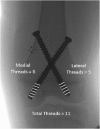Percutaneous Epiphysiodesis Using Transphyseal Screws: a Case Series Demonstrating High Efficacy
- PMID: 28983218
- PMCID: PMC5617815
- DOI: 10.1007/s11420-017-9549-5
Percutaneous Epiphysiodesis Using Transphyseal Screws: a Case Series Demonstrating High Efficacy
Abstract
Background: Percutaneous epiphysiodesis using transphyseal screws (PETS) has been associated with implant failure, implant prominence, angular deformities, and delayed growth inhibition.
Questions/purposes: The aim of this study was to assess the complication rate and efficacy (defined as actual growth inhibition divided by expected growth inhibition) of PETS and to identify factors associated with improved efficacy.
Methods: Patients who underwent distal femoral and/or proximal tibial PETS between January 2007 and June 2014 were identified. Complications, efficacy, and final limb-length discrepancy (LLD) were calculated using multipliers and inhibition rates based on previous growth. Associations between efficacy and screw insertion angle (SIA), body mass index, and number of threads crossing the physis were calculated.
Results: Eight-two patients (126 treated physes) were included. The mean pre-operative LLD was 27.7 mm (SD = 7.5). Following epiphysiodesis, 15 had temporary pain (18%), five had temporary effusion (6.1%), four had broken implants (4.9%), four developed mild angulation (4.9%), and three had failed epiphysiodesis requiring revision (3.7%). Thirty-one underwent screw removal (n = 31, 38%). Mean LLD at maturity was 17.3 mm (SD = 5.8 mm). Mean efficacy at the distal femur was 97% (SD = 46%), at the proximal tibia was 108% (SD = 66%) and was 103% (SD = 57%) overall. Increased screw threads across the lateral proximal tibial physis (Spearman's correlation coefficient = 0.67; 95% CI = 0.40-0.94) and higher BMI (Spearman's correlation coefficient = 0.55; 95% CI = 0.34-0.77) were positively associated with increased efficacy.
Conclusions: The efficacy of PETS may be more favorable than previously reported. Only 3.7% had serious complications requiring revision epiphysiodesis, lower than previous reports. Attention to sufficient screw threads across the physis may be important in optimizing PETS results.
Keywords: PETS; complications; efficacy; epiphysiodesis; limb length discrepancy; percutaneous screws.
Conflict of interest statement
Conflict of Interest
Emily R. Dodwell, MD, MPH, FRCSC; Matthew R. Garner, MD; Elise Bixby, BA; Eva M. Luderowski, BA; Daniel W. Green, MD; John S. Blanco, MD; and Roger F. Widmann, MD, have declared that they have no conflict of interest.
Human/Animal Rights
All procedures followed were in accordance with the ethical standards of the responsible committee on human experimentation (institutional and national) and with the Helsinki Declaration of 1975, as revised in 2008 (5).
Informed Consent
Informed consent was obtained from all patients for being included in the study.
Funding
This research was funded through the Hospital for Special Surgery Pediatric Council Grant and the HSS Medical Student Summer Research Fellowship Program.
Required Author Forms
Disclosure forms provided by the authors are available with the online version of this article.
Figures
References
-
- Bowen JR, Johnson WJ (1984) Percutaneous epiphysiodesis. Clin Orthop Relat Res 170–3. - PubMed
-
- Bylski-Austrow DI, Wall EJ, Rupert MP, Roy DR, Crawford AH Growth plate forces in the adolescent human knee: a radiographic and mechanical study of epiphyseal staples. J Pediatr Orthop 21:817–23. - PubMed
-
- Campens C, Mousny M, Docquier P-L. Comparison of three surgical epiphysiodesis techniques for the treatment of lower limb length discrepancy. Acta Orthop Belg. 2010;76:226–32. - PubMed
-
- ST, Christian CA (1990) Techniques for epiphysiodesis about the knee. Clin Orthop Relat Res 81–5. - PubMed
LinkOut - more resources
Full Text Sources
Other Literature Sources
Molecular Biology Databases




